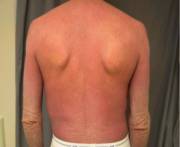Case Presentation: 83 year old with a past medical history of hypertension noted erytematous plaques with scale about 1 year ago. The rash was associated with diffuse pruritis at that time. The patient subsequently underwent several inconclusive biopsies. She was eventially diagnosed with mycosis fungoides and treated with UV therapy. Her rash progressed to a diffuse pruritic erythema covering the vast majority of her body, including palms and soles. (erythroderma). She was noted to have Sezary cells on peripheral smear and diagnosed with Sezary syndrome. She was now admitted to TH with fevers likely secondary to cellulitis on her lower extremities, the site of significant skin breakdown. The patient is improving on treatment with IV antibiotics and interferon alpha. (image courtesy of The Internet Journal of Dermatology)
Teaching Points:
1. What is Mycosis fungoides:Extranodal Non-Hodgkins lymphoma of T-cell origin, with primary involvement of the skin
What is Sezary Syndrome:
- Generalized erythroderma
- Lymphadenopathy
- Atypical T- cells (Sezary cells) in the peripheral blood
2. Tumor grades
- T1 Limited patch/plaque (< 10 percent of total skin surface)
- T2 Generalized patch/plaque (>10 percent of total skin surface)
- T3 Tumors
- T4 Generalized erythroderma
These four tumor grades correlate with median survivals approximately 30 years, 12 years, 5 years, 4 years, respectively. Note that T1 and T2 are usually not dying of the disease while T3 and T4 are.
3. Therapy-correlates with prognosis. T1 and T2 will receive almost exclusively topical therapy with nitrogen mustard, UVA, UVB and Electron beam therapy. T3 and T4 will likely require topical and systemic medications, immunomodulators and chemotherapy.
Short Powerpoint on Sezary Syndrome
Please note that the survival curves are for T1, T2, T3, and T4 tumor grade. The photos how the diffuse patchy presentation, followed by erythroderma.
Becker, D. Clinical Correlations (NYU Internal Medicine Residency Blog) Dec. 11, 2006. Available from http:// Litvin, C. Clinical Correlations (NYU Internal Medicine Residency Blog) Dec. 12, 2006. Available from https://www.clinicalcorrelations.org/?p=54

